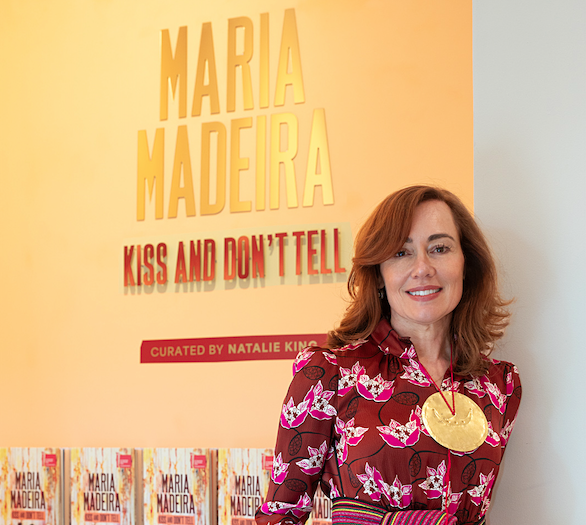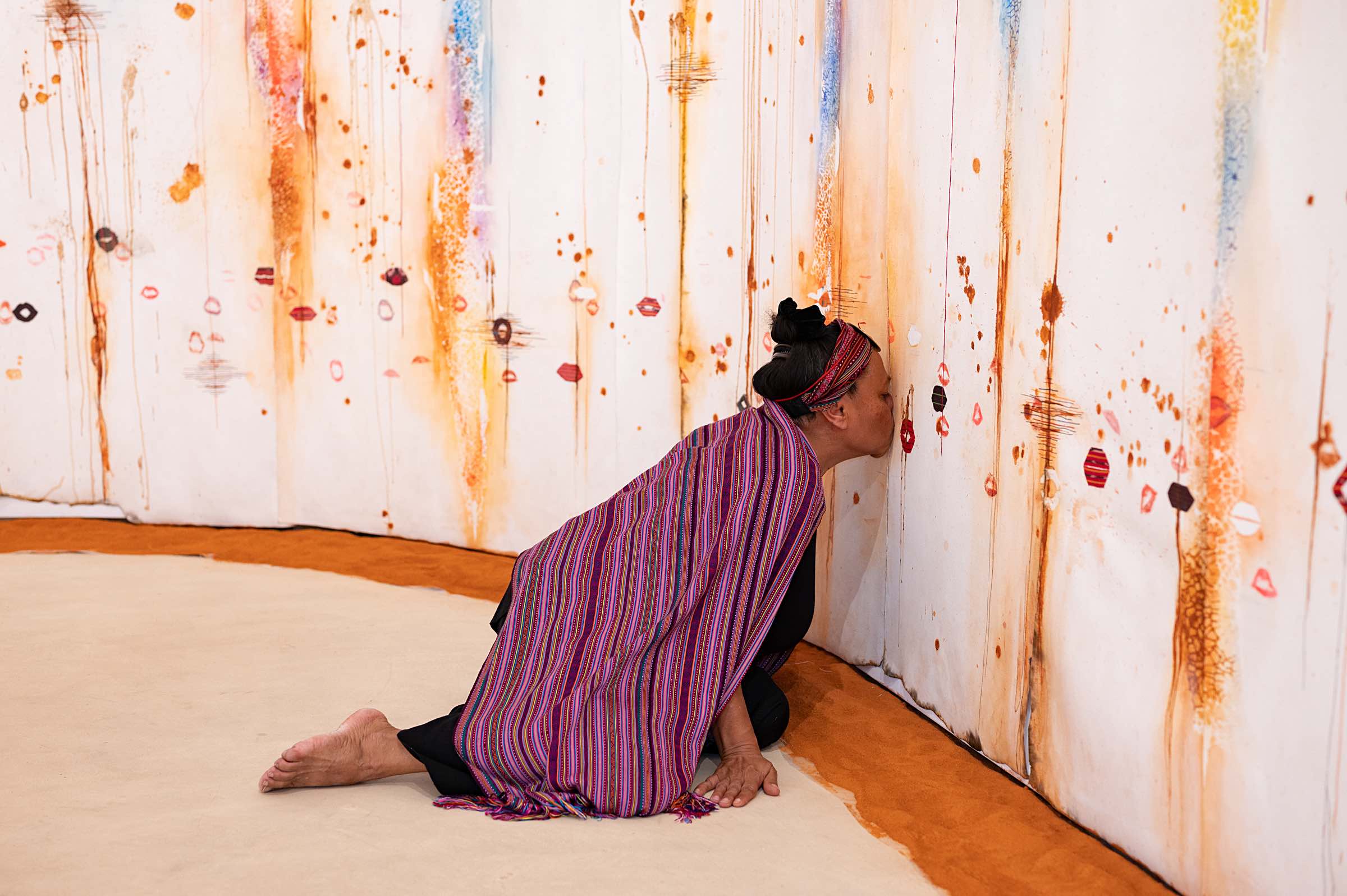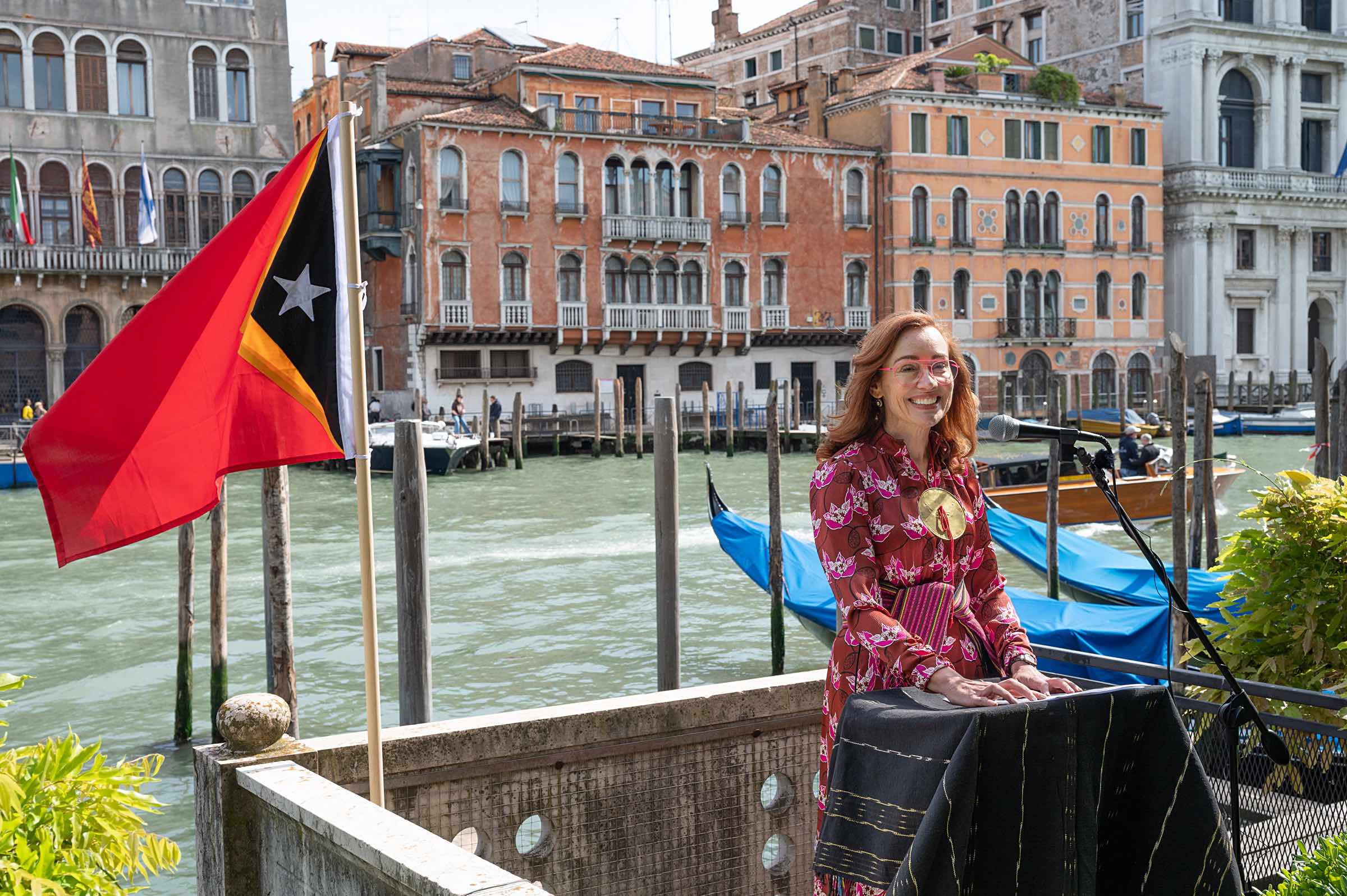'A sense of joy and jubilation' — Enterprise Professor Natalie King reflects on the 2024 Venice Biennale

Natalie King is a leading Australian curator, writer and senior researcher engaged with artists and institutions across the Asia-Pacific region. Currently Enterprise Professor at the Faculty of Fine Arts and Music, Natalie has extensive curatorial experience in contemporary art across Australia, Asia-Pacific and Europe.
Natalie was the curator of Tracey Moffatt’s acclaimed exhibition for the Australian pavilion at the 2017 Venice Biennale and Yuki Kihara’s exhibition Paradise Camp for the Aotearoa New Zealand Pavilion at the 2022 Biennale. Natalie shares her insights into curating the inaugural Timor-Leste pavilion, Maria Madeira: Kiss and Don’t Tell, at this year's 60th Venice Biennale.
Can you tell us a little bit about Maria Madeira: Kiss and Don’t Tell and the significance of the inaugural Timor-Leste pavilion?
Maria Madeira is the first artist to represent Timor-Leste at the 60th Venice Biennale, coinciding with the 25th anniversary of country’s referendum for independence. As the most prestigious and oldest visual arts event in the world, La Biennale comprises over 90 national pavilions who coexist, side-by-side in the lagoon city of Venice, apprehending some of the most urgent issues of our times.
Concurrently, Stranieri Ovunque – Foreigners Everywhere (curated by Adriano Pedrosa) is the main curated exhibition with the concept of a foreigner in tumultuous times across countries, nations and borders. With a focus on diasporic, immigrant and exiled artists, this edition resonates with Maria Madeira’s personal history of multiple migration, exile, forced evacuation and displacement. Moreover, Madeira is incredibly resourceful as there are no art supply stores in Dili so she utilises materials at hand such as diluting the red earth of her village, pulling out threads from the traditional textile tais and using it as fine lines as well as collaging lips across the base of her painting installation.
Madeira was born in Gleno, a village in Ermera, the third of ten siblings within an agricultural family. Timor-Leste was a Portugese colony for 500 years yet within days of leaving, Indonesia invaded in November 1975. Soon after, adolescent Madeira and her family were evacuated to a refugee camp run by the Red Cross on the outskirts of Lisbon. Here she found solace singing in an East Timorese choir songs such as Ina Lou – Dear Mother Earth forming the soundtrack to Kiss and Don’t Tell. It’s a triumph that Madeira’s installation - redolent with pain and healing - is presented at the Venice Biennale. I also feel honoured to curate Timor-Leste alongside other first-time pavilions such as Lagos, Nigeria, Tanzania and Benin.

What are some themes or issues that Kiss and Don’t Tell touches on?
Kiss and Don’t Tell is an ensemble exhibition comprising 25 conjoined and suspended paintings grounded with red earth on the gallery floor to link with the red ochre of Madeira’s hometown. Accompanying the painting installation, is a single channel film directed by Robert Connolly, in which Madeira performs the story of Kiss and Don’t Tell and sings traditional songs. Her voice becomes the soundtrack to the exhibition as she narrates a painful tale. Madeira also made a new intervention onsite by kissing an arched window with hundreds of lipstick smudges.
The genesis of Kiss and Don’t Tell traces back to 2000, when Madeira returned to help with the recovery and rebuilding of her country. Two years later, she worked as an interpreter, translator and cultural advisor for the United Nations Serious Crimes Unit helping Timorese people convey their experiences. At the time, Madeira stayed in a bedroom at her brother’s home where she discovers lipstick stains on the base of the walls as if these mouths were trying to talk to her. After building trust with neighbouring villagers, she discovered that this bedroom, along with others, were used as torture rooms by the Indonesian invaders. Women were forced to kiss the walls while being raped. For Madeira, the men fought with guns but the women fought with their bodies. Madeira gives voice to the harrowing story of Timorese women, shedding light on their silent heroism but also inflects her tale with beauty, hope and healing.

How has the Timor-Leste pavilion been received at Venice?
Even though we had a compressed timeframe, it has been a momentous occasion and joyful experience curating the Timor-Leste pavilion, opened by the Prime-Minister and freedom fighter Xanana Gusmão. Madeira performed and we celebrated by singing traditional Timorese songs while dancing beside a canal throughout the evening.
Apollo magazine referred to Timor-Leste as a ‘must-see pavilion at the Venice Biennale 2024’ and The New York Times announced that ‘Indigenous artists are the heart of the Venice Biennale’ while The Sydney Morning Herald declared ‘a landmark moment for the artist as an individual and also for the nation state’. To date, we have also had positive coverage in Ocula, The Saturday Paper, The Art Newspaper and Art Asia Pacific. I feel that Madeira is receiving the acknowledgement that she deserves by giving voice to the voiceless in such a powerful and poetic way. We also produced a publication in record time with the renowned Italian publisher Skira, including an introduction and poems by Prime Minister Xanana Gusmão, an insightful essay by Dr Kim McGrath that traces the geopolitical history of Timor and a reportage text by Antonio Sampaio who researched the torture bedrooms in 1999 and published account in the news service Lusa.

This is your third time curating a national pavilion at the Venice Biennale – how has the Biennale changed during this period?
I never set out to curate three national pavilions, and I think that I am the only person to curate on three occasions. Having said that, it has been interesting to reflect on this curatorial arc, firstly in the Giardini with Tracey Moffatt: My Horizon in the Australian pavilion in 2017, Yuki Kihara: Paradise Camp for Aotearoa New Zealand pavilion in the Arsenale in 2022 and now Maria Madeira: Kiss and Don’t Tell in an offsite venue, Spazio Rava, on the Grand Canal, close to Prada Foundation and the Rialto market.
Working across three different settings has helped me understand the immense impact that La Biennale has on an artist and audiences. Each pavilion has had varying resourcing, infrastructure and teams though I can certainly attest to the deep commitment, generosity of spirit and kindness of the Timorese Ministry, led by our Commissioner and Secretary of State, Jorge Soares Cristovão with advisors Anna Schwartz AM, Dr Kim McGrath and Simon Fenby. We had to scale up quickly and assemble a ‘dream team’ so I am immensely grateful for the team effort and many late-night zooms. From the outset, Madeira and I found an inherent trust between us as we are born in the same year and hold family and feminism close.
How has your curatorial practice evolved from your experiences at Venice?
I realised that when I first curated a pavilion with Tracey Moffatt in 2017, there is limited contact between pavilions let alone sharing of experiences, resources and camaraderie. I remember going around bashfully to nearby pavilions in the Giardini during install, knocking on doors and introducing myself. I ended up having regular lunches with Cecilia Alemani who was then the curator of the Italian Pavilion and Susanne Pfeffer who was curator of the German Pavilion with Anne Imhof. We were able to share stresses and triumphs as well as practicalities of navigating Venetian regulations.
This year, a group of more than 24 female curators of national pavilions formed a WhatsApp group that has subsequently expanded, providing practical advice, solidarity and camaraderie. The curator of the Croatian Pavilion, Antonia Majaca invited me into the group that was formed by curator Tarini Malik of the British Pavilion. We had dinner prior to vernissage in St Elena and it was a relief to discuss feverish installation schedules, printing delays and heightened emotions. I feel grateful to be part of such a supportive group all of whom were elated when Ellie Buttrose and Archie Moore won the Golden Lion for the Australian pavilion.
Now, I am in the process of forming an alliance with other pavilions, working towards a discursive gathering in the closing weeks of La Biennale in November along with Ca’Foscari, University of Venice. Since Timor-Leste was a Portugese colony for 500+ years and given Maria was in a refugee camp, it seems prescient that we instigate dialogue across pavilions to discuss soil, sea and solidarity. I hope there will be more occasions for programming between pavilions rather than the tendency towards a singular focus.

What have been some highlights of the 2024 Biennale?
2024 La Biennale continues to give voice to overlooked artists, First Nations artists and older artists. There seemed to be a sense of joy and jubilation in some of the pavilions especially Jeffrey Gibson in the US Pavilion with his exuberant patterns and bejewelled figures emblazoned across the façade and interior as the First Indigenous artist to represent the US. Also, Julien Creuzet’s hybrid and amorphous forms combines digital media, sound and poetic collages, curated by Céline Kopp and Cindy Sissokho. The Nigerian pavilion is excellent with a group presentation of utopic visions for a new Nigeria. Apinan Posyananda, the renowned Thai curator has assembled a collateral event called The Spirits of Maritime Crossing at Palazzo Smith Mangilli Valmarana with artists exploring sea-based communities and maritime histories to revive ancestral knowledge.
Have there been any challenges?
The main challenge was the compressed time frame as usually I have up to two years to curate a biennale and I was only contracted in January 2024. Nevertheless, we managed to build a skilled team with whom I had previously worked with and set up a purposeful momentum from the outset. In some ways, it has been a miracle that the team came together with so much goodwill and skills. Little did I know that when my friend and gallerist, Anna Schwartz contacted me last August, that I would find myself curating a third Venice Biennale.
I am, however, looking forward to “slow curating” the forthcoming Kathmandu Triennale in February 2026 and collaborating with co-Artistic Director, Associate Professor Sujan Chitrakar from Kathmandu University. Our concept is “Coexistence” and we are working towards a transformed biennale/Triennale model that is more sustainable and less extractive.
It was exciting to see that Indigenous Australian artist Archie Moore won the prestigious Golden Lion for his artwork kith and kin featured at the Australia Pavilion. Do you have any reflections on the significance of this prize for Indigenous Australian contemporary art?
It was momentous when Archie Moore won the Golden Lion for Australia for the first time. His work is deeply profound and singular, tracing his ancestry via a family tree that covers the entire wall and ceiling surface contrasted with documents from deaths in custody. I hope that finally, there might be more orientation and acknowledgement of artists in our region and the stories we can tell to the world.